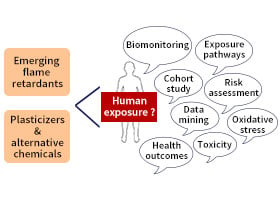Human Exposure to Emerging Flame Retardants and Alternative Plasticizers
A special issue of International Journal of Environmental Research and Public Health (ISSN 1660-4601). This special issue belongs to the section "Environmental Health".
Deadline for manuscript submissions: closed (31 July 2022) | Viewed by 32881

Special Issue Editors
Interests: plasticizers; emerging pollutants; endocrine disrupting chemicals; melamine; analytical toxicology
Interests: emerging contaminants; human exposure; environmental processes; food chains; metabolism; mechanism of toxicity
Special Issues, Collections and Topics in MDPI journals
Interests: environmental fate; flame retardants; passive sampling; exposure assessment; transformation products
Special Issue Information
Dear Colleagues,
We are organizing a Special Issue on “Human Exposure to Emerging Flame Retardants and Alternative Plasticizers” for the International Journal of Environmental Research and Public Health (IJERPH).
Some of the chemicals that have been used in consumer products have been found to be toxic, and their exposure in humans is linked to various environmental diseases, such as hormonal dysfunction, neurological disorders, kidney diseases, and various cancers. Hence, there has been a rapid increase in the replacement of such harmful chemicals with alternative chemicals in consumer products. However, the toxicity profiles of such emerging alternative chemicals are often either unclear, or they tend to possess similar toxicity to the original toxic chemicals. Thus, it is important to assess the exposure levels and sources of such emerging replacement chemicals and their associated impacts on human health. Among environmental chemicals, plasticizers and flame retardants are a group of high production volume chemicals that have been extensively used for domestic and industrial purposes. In recent decades, some of the harmful legacy chemicals used as plasticizers and flame retardants have been replaced with several alternatives, leading to inevitable exposure to these emerging chemicals in humans and their potential release into the environment. However, there is still a dearth of information on some of these replacement chemicals, such as their exposure levels in various populations, cumulative risk assessments, associated biomarkers, health outcomes, exposure pathways, toxicological effects, reference doses, threshold values, etc.
Therefore, this Special Issue is mainly focused on research works addressing these critical issues and expanding the knowledge of emerging replacement chemicals. Studies on target compounds such as OPFRs, NBFRs, polychlorinated flame retardants (Dechlorane Plus), TBBPA, HBCDs, PFAS replacements, melamine, DINCH, BPA alternatives, terephthalate, and other emerging relevant chemicals will be given high priority. We encourage the submission of original research or review articles emphasizing these emerging contaminants using biomonitoring studies (including metabolites and transformation products in humans), epidemiological investigations and other exposome approaches, exposure assessment studies (via food and environmental monitoring), and data-mining and informatics approaches to this Special Issue. Manuscripts reporting novel analytical methods (sampling and analytical strategies) and toxicological studies conducted on these emerging chemicals and their metabolites are also welcomed.
Dr. Karthikraj Rajendiran
Dr. Tao Zhang
Dr. Un-Jung Kim
Dr. Maria Pilar Martinez-Moral
Guest Editors
Manuscript Submission Information
Manuscripts should be submitted online at www.mdpi.com by registering and logging in to this website. Once you are registered, click here to go to the submission form. Manuscripts can be submitted until the deadline. All submissions that pass pre-check are peer-reviewed. Accepted papers will be published continuously in the journal (as soon as accepted) and will be listed together on the special issue website. Research articles, review articles as well as short communications are invited. For planned papers, a title and short abstract (about 250 words) can be sent to the Editorial Office for assessment.
Submitted manuscripts should not have been published previously, nor be under consideration for publication elsewhere (except conference proceedings papers). All manuscripts are thoroughly refereed through a single-blind peer-review process. A guide for authors and other relevant information for submission of manuscripts is available on the Instructions for Authors page. International Journal of Environmental Research and Public Health is an international peer-reviewed open access monthly journal published by MDPI.
Please visit the Instructions for Authors page before submitting a manuscript. The Article Processing Charge (APC) for publication in this open access journal is 2500 CHF (Swiss Francs). Submitted papers should be well formatted and use good English. Authors may use MDPI's English editing service prior to publication or during author revisions.
Keywords
- phthalate replacement
- alternative flame retardants
- biomonitoring studies
- human health
- exposure pathways
- risk assessment
- cohort study
- metabolite toxicity
- data mining
- oxidative stress markers
Benefits of Publishing in a Special Issue
- Ease of navigation: Grouping papers by topic helps scholars navigate broad scope journals more efficiently.
- Greater discoverability: Special Issues support the reach and impact of scientific research. Articles in Special Issues are more discoverable and cited more frequently.
- Expansion of research network: Special Issues facilitate connections among authors, fostering scientific collaborations.
- External promotion: Articles in Special Issues are often promoted through the journal's social media, increasing their visibility.
- Reprint: MDPI Books provides the opportunity to republish successful Special Issues in book format, both online and in print.
Further information on MDPI's Special Issue policies can be found here.








